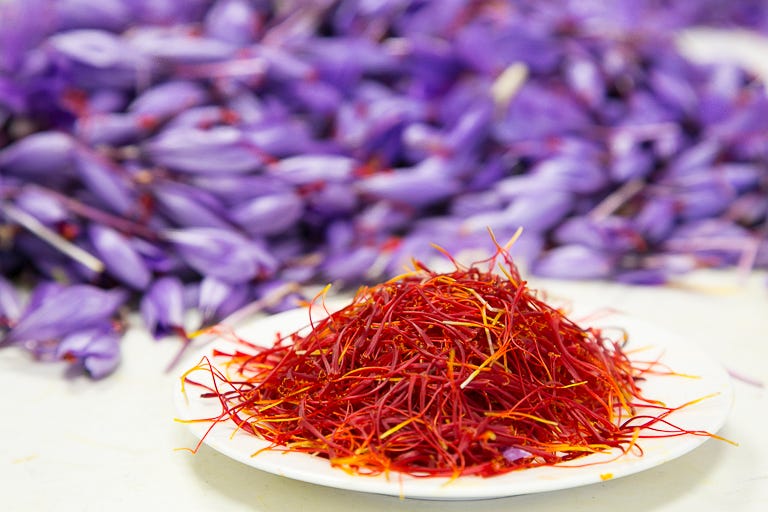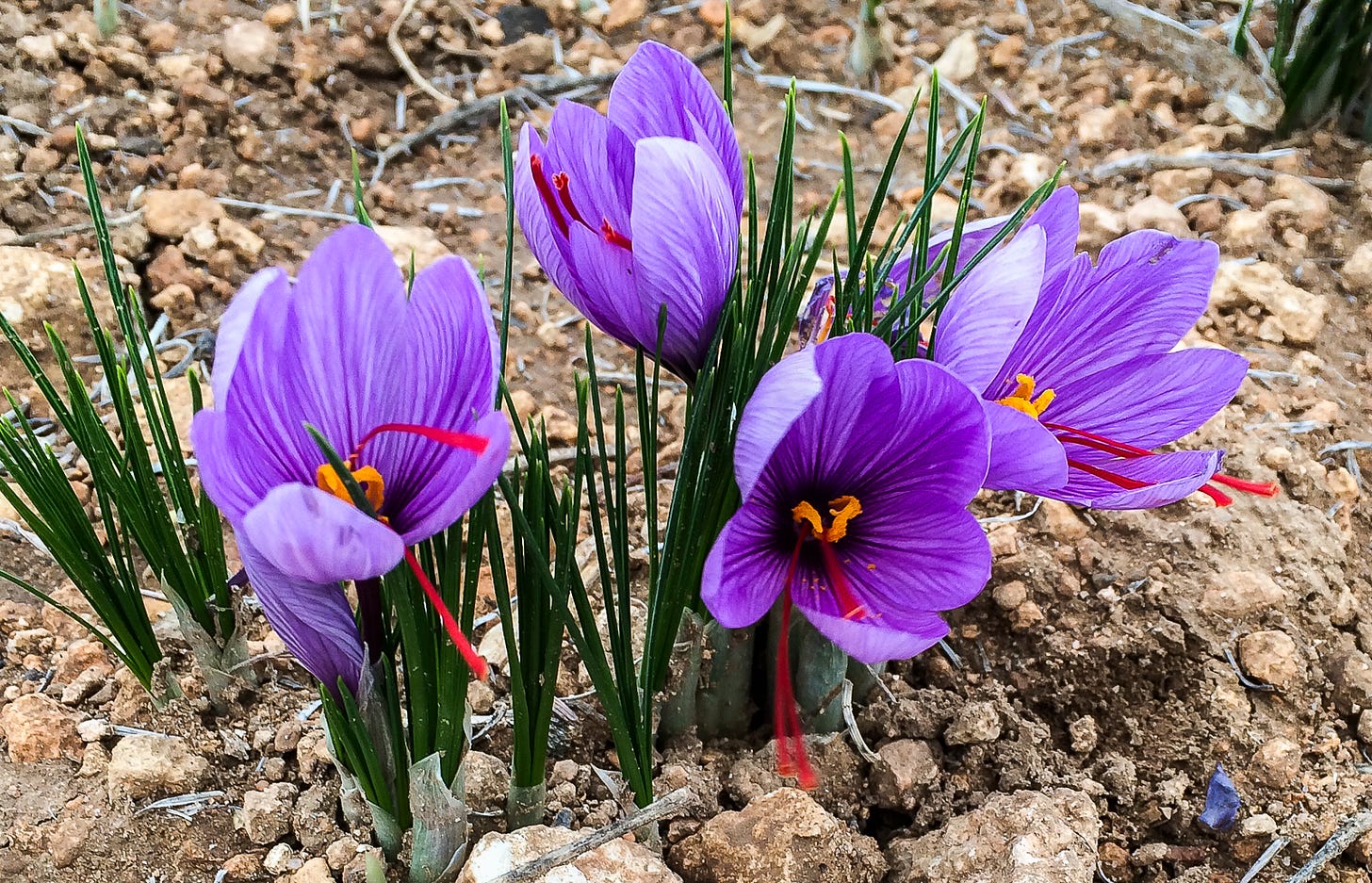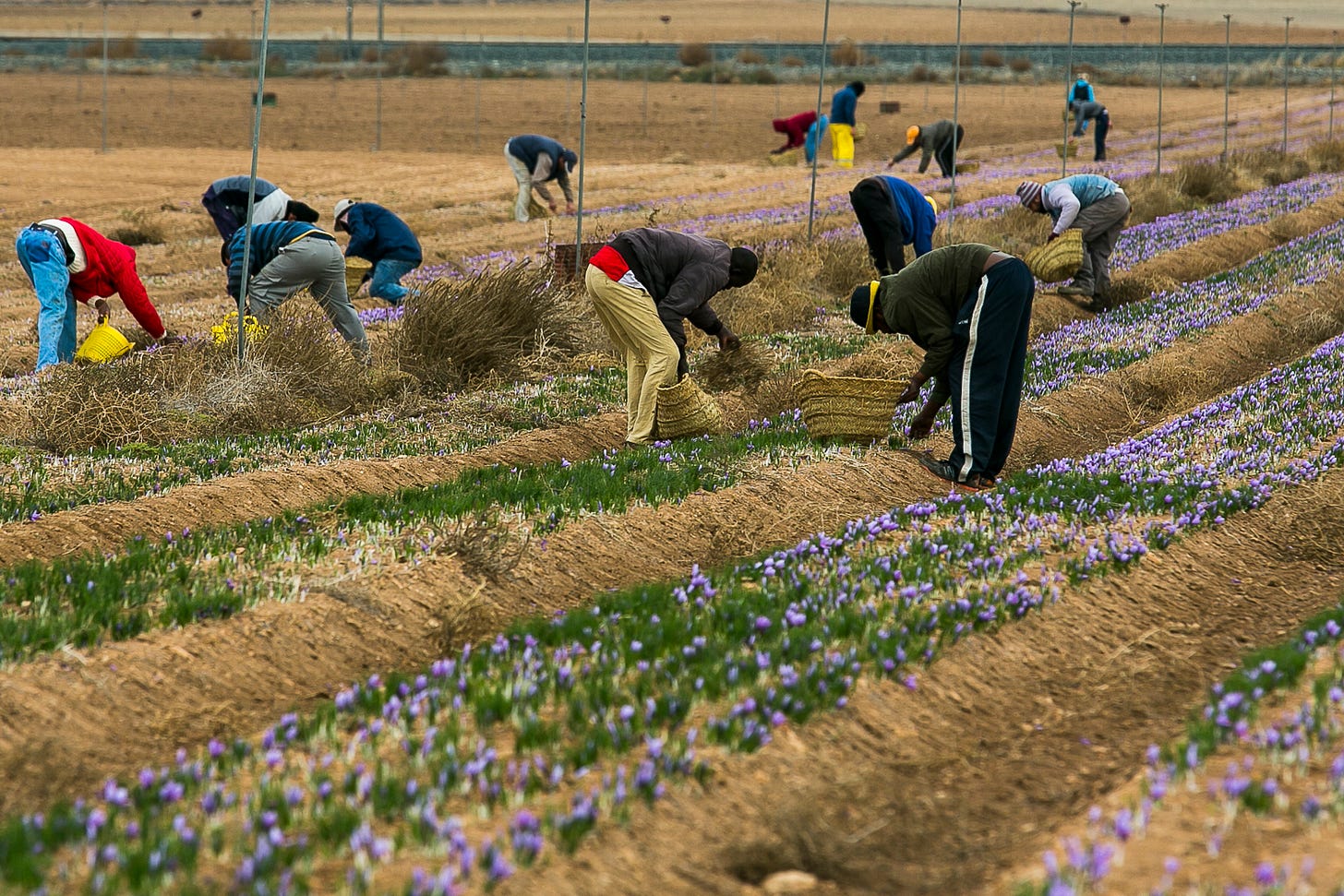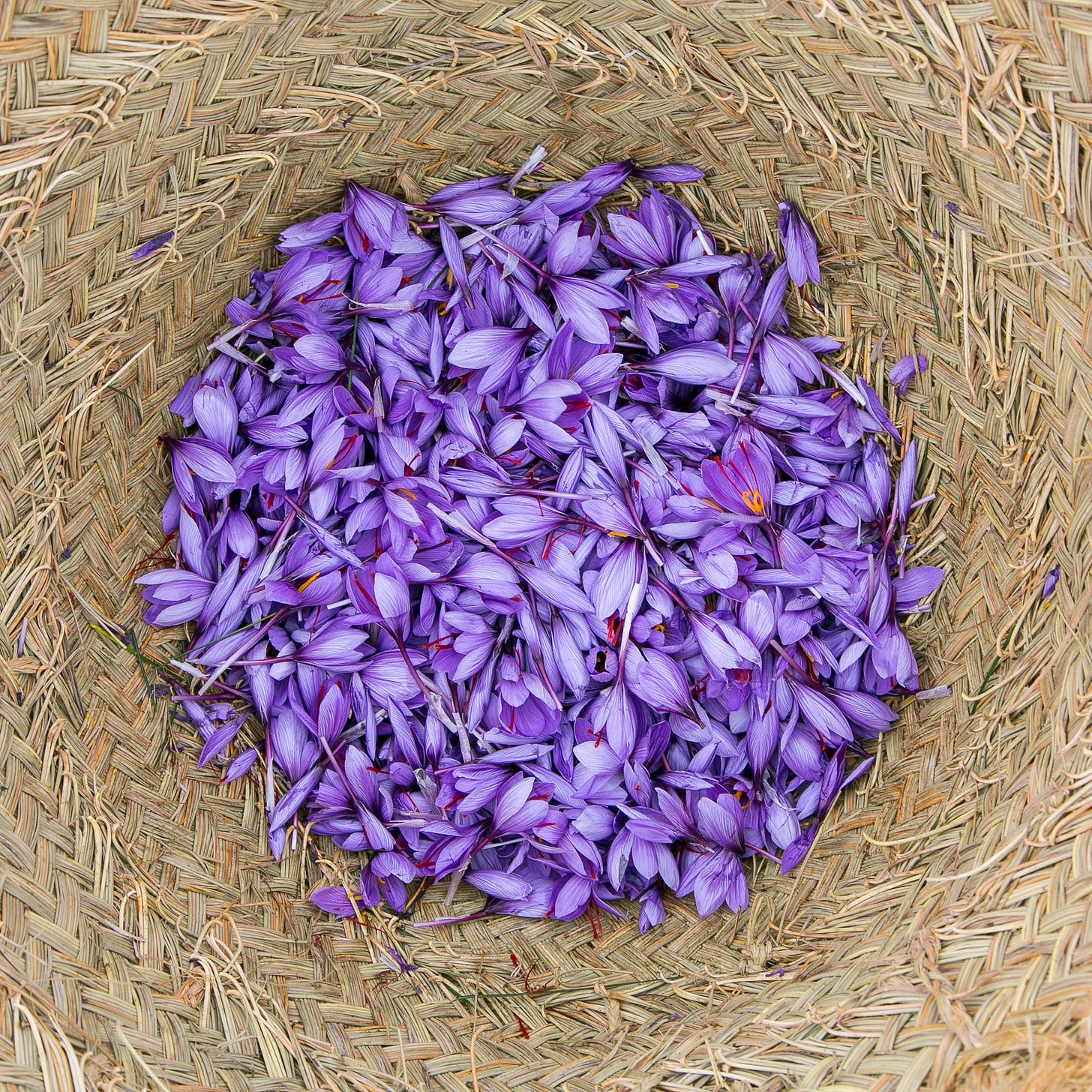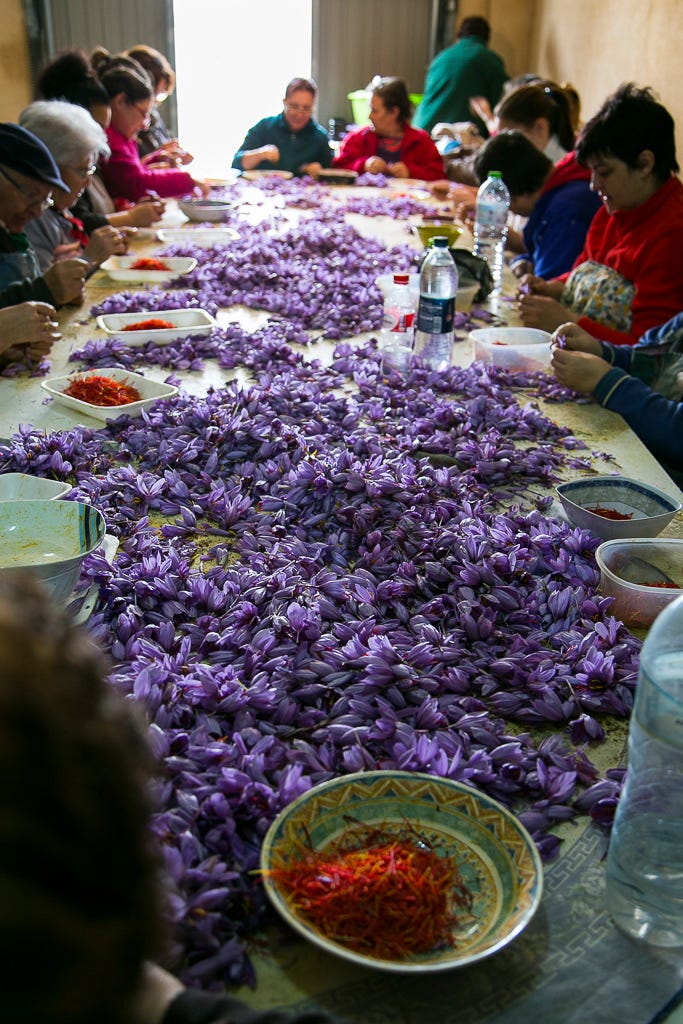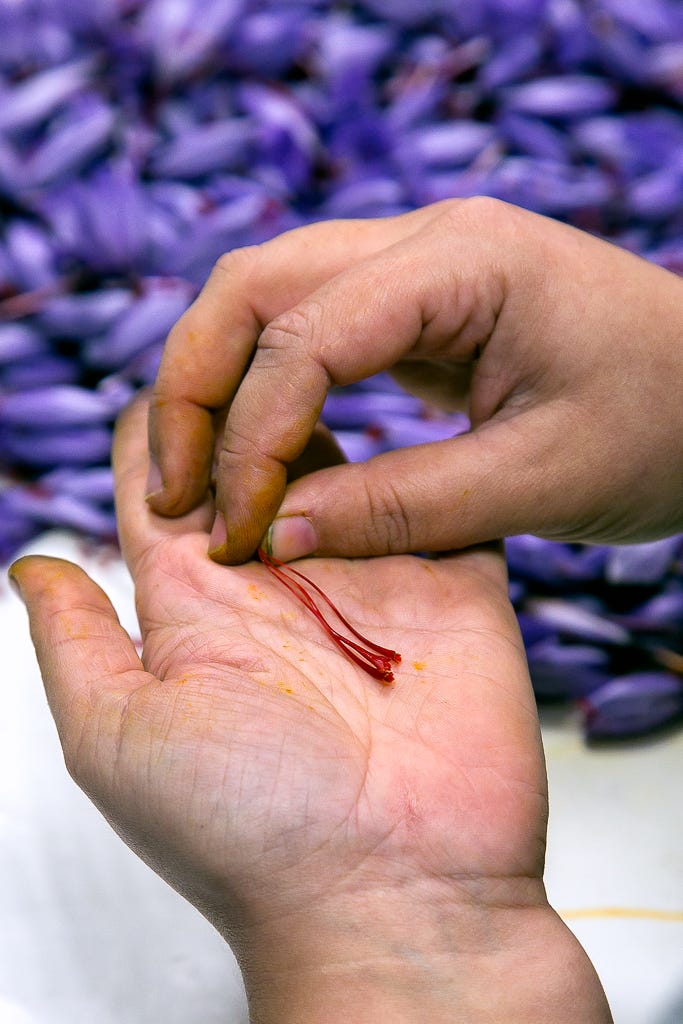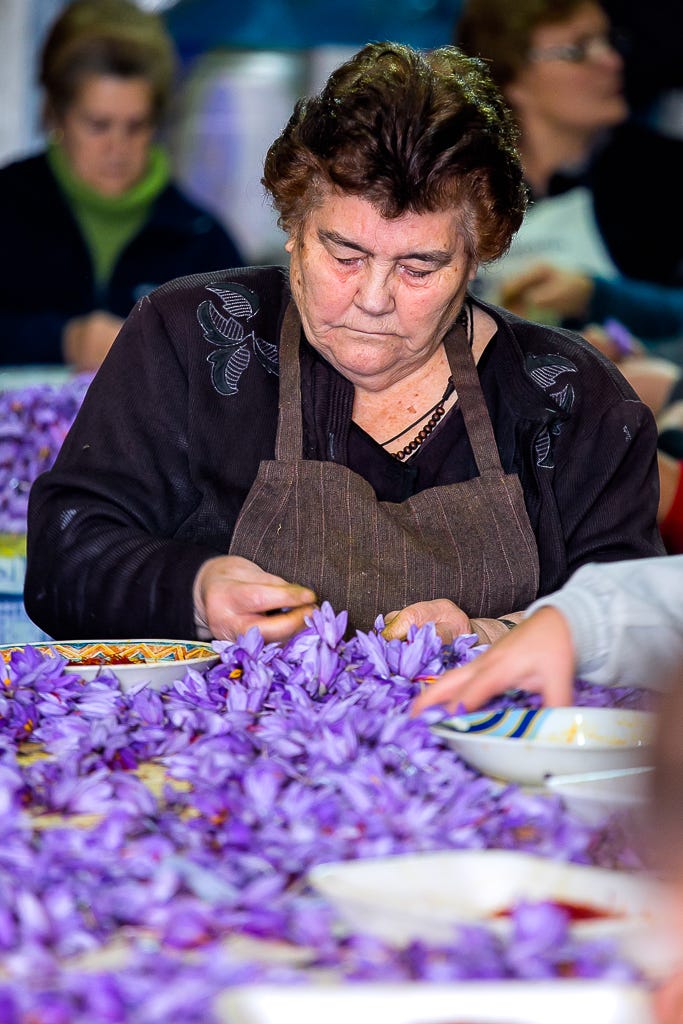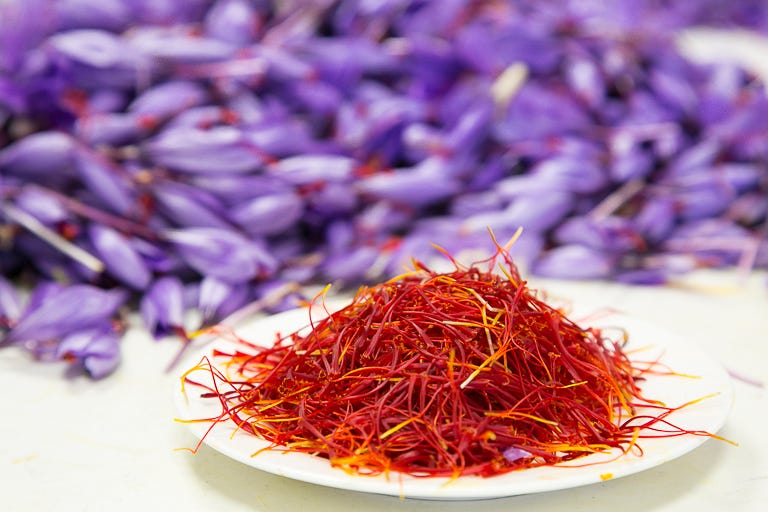saffron: a Spanish kitchen's BFF
Of all the influences on Spain’s iconic culinary style, it was the Arab impact of bringing the spice azafrán or saffron known as “red gold” to the Spanish table that infuses Spanish cooking with its classic deep yellow color and slightly musky, rich taste.
But for many American cooks like myself, saffron is still surrounded in a bit of mystery. The three-pronged stigma from the center of a saffron flower, at almost $20/gram, it’s super pricey. It has an aroma and flavor that hovers between floral and bitter citrus with metallic undertones. And like extra virgin olive oil, its somewhat dodgy history of fraud and adulteration serves as yet another culinary example of all that glitters is not necessarily gold.
When I returned from a trip to Spain 15 years ago, the customs officer discovered three precious glass vials of saffron buried deep in my suitcase. But with a raised eyebrow and a slight shrug, he waved me through. I stashed it away like my grandmother’s heirloom jewelry, anxiously waiting for the perfect recipe to showcase these dark red-orange threads, unknowingly saving it well past its prime. Because like other spices, saffron is best when fresh and does not improve with age.
Recently, I traveled back to the La Mancha region of Spain. While it might be best known for its iconic windmills and hapless hero Don Quixote, it was the acres and acres of inches-tall small crocus flowers that I was after. As guest of Verdú Cantó, one of the largest saffron distributors in Spain, I spent the morning with Rodolfo Encarnación Marin, manager of the Corporacion de Operadores de Azafrán Español, deep in the heart of Spain’s saffron country, to learn all I could about this quintessential Spanish ingredient known as the world’s most expensive spice.
A crusty brown skin conceals a heart of gold for the finest crocus corms of Spain. Once the flower harvest is complete, producers winnow out the best corms to yield three to five new plants for next season.
Marin explained that Spanish producers typically cycle their corms through a four-year process to retain the best color and most intense flavor. Iran may supply 90% of the world’s production, but Spain’s attention to consistently high quality in flavor, intensity and color awards this country’s crop the premium price it commands.
In the field, the flower known as the saffron rose has an unassuming air. Simple and delicate, its blossom opens in the early morning, taking on a vibrant purple hue over the bleak, dry landscape, then collapses in the heat of the day.
While saffron’s history is mostly tied to culinary uses, over millennia its curative powers have been applied to a wide variety of ailments including hangovers, a waning libido, and sleeplessness. In this decade, scientific studies have focused on saffron’s potential value as a natural anti-depressant and possible cancer fighter.
A field that seemed to stretch for miles was bitter cold from wind that whistled like an oncoming train, but with numbing fingers, I held my camera tight to witness my first manto or saffron harvest.
When we arrived just past daybreak, harvesters were already halfway through their three-hour day, racing to gather up the delicate purple blanket covering the dusty ground before sunlight would wither the blossoms, making them useless.
On this rainless morning, we were lucky. Weighty clouds overhead meant that the opened flowers might last an extra hour. But that didn’t mean the sense of urgency was any less palpable. It was the last day of a three-week annual harvest that would yield Spain’s total tonnage of the world’s most expensive spice.
I watched as workers bent over thousands of crocus plants to gently pluck the last flowers of the season containing the precious three-pronged stigma that would be extracted and dried into a spice worth more than its weight in gold.
According to Marin, saffron requires 150,000 to 200,000 flowers to produce one kilogram of the dried spice and every stage of its production is a labor-intensive process. A good haul of flowers in a short three-hour workday can be as little as 8 kilos and as much as 20 kilos per harvester, returning 50 euros to the best for their morning’s effort.
In the field, I received a first-hand lesson in the push-pull-pop technique of proper saffron harvesting. But my newfound skill was hardly fast enough to keep up with my tutor, so I mostly watched as straw baskets full of flowers were emptied into eye-high stacks of shallow plastic trays and piled into a van, disappearing down a tiny dirt road to a nearby town where monadoras were waiting to handle the next part of the process.
With no outside signs to reveal the bustle of activity in a small windowless building, a heavy metal door opened to reveal a throng of men and women, young and old, all carefully extracting saffron threads from crocus blooms. The towers of shallow plastic crates (to ensure that the flowers weren’t compressed by weight) were hurried in and unceremoniously dumped one by one to ensure that no one was ever shy of flowers.
Experts in gently separating the saffron from the flower while keeping the 3-thread stigma intact (a process known as desguince or desbrizne), hands worked fast as the floor filled with spent flowers. Like a perfume factory lacking white coats and laboratory beakers, the heady scent of fresh saffron was matched by the noise of constant conversations and laughter, and the intense bright colors of purple and red that filled with the room.
I was anxious to touch the flowers, pluck the precious stigma from their centers, and smell the fresh aroma on my fingers. The mondadoras were happy to put me straight to work, opening up some table space, offering an extra chair and sharing a pair of reading glasses for the delicate work.
"Seasoned" hands with little indication of the day’s effort showed off the perfect saffron specimen, while I was rewarded with a deep purple stain that tattooed my fingernails for days and a telltale red reminder that gave away my novice status. No self-respecting mondadora would have a speck of precious red gold left to show from their lighting-fast extraction of the three-pronged stamen.
But despite the warm-hearted welcome, make no mistake: Saffron is serious business in Spain. When 1 kilogram of dried saffron threads can take up to 400 man-hours to produce, every broken piece of thread, no matter how small, was noticed and saved. Just like the spice they meticulously collect, seasoned extractors are also worth their weight in gold. They work furiously fast with little waste and less chitchat.
The drying process takes place under high security in yet another isolated location. This final step required a light roasting to remove 88% - 92% of the stigma’s moisture to meet strict DO (denominacíon de origen) certification. Five kilograms of stigma weight that goes into the roaster returns only one kilogram of dried threads.
While saffron may be the world’s most expensive spice, used properly these exquisite artisanal red-orange threads are worth every dollar. Here’s are a couple of pointers to help you make the most of a very wise investment:
Always buy saffron in thread form—not powder, which is known to be easier to adulterate with other spices like turmeric.
Look for a Spanish D.O. (denominación de origen) and production date on the label to ensure the best quality.
Before adding to most recipes, grind it gently between your fingers and rehydrate with a bit of very hot water. You might be advised to roast it to bring out the flavor but if it’s truly fresh this will diminish, not enhance, its subtle aromas.
Use a deft and light hand. Fortunately, just a few threads of saffron add a slightly smoky aroma of tobacco and cedar, a luscious flavor infused with undercurrents of pepper and citrus, and brilliant red-orange color.
Saffron is equally at home in dishes from savory paellas to sweet intensely flavored ice cream. Don’t be afraid to experiment—you will be rewarded with a unique twist on traditional tastes that add a bit of Spanish mystery to your menu.
Note
The best, most reliable shop I know to source saffron in the United States is the Spanish specialty online store, www.latienda.com.



